Creating a compelling brand identity package is the foundation of successful business branding. When businesses invest in professional branding services, they receive much more than just a logo—they get a comprehensive visual system that communicates their values, builds recognition, and establishes trust with customers. This complete guide breaks down the essential components of a brand identity package and explains how each element works together to create a cohesive brand presence.
What is a Brand Identity Package?
A brand identity package is a comprehensive collection of visual and messaging elements that define how your brand looks, feels, and communicates across all touchpoints. Unlike a single logo design, a complete branding package includes multiple interconnected components that work together to create a unified brand experience for customers.
Modern brand identity packages typically include four core components: logo design with variations, color palette systems, typography guidelines, and comprehensive brand guidelines documentation. These elements ensure consistency across all marketing materials, from business cards to websites and social media platforms.
Research shows that consistent brand presentation across all platforms can increase revenue by up to 23%, making a well-designed brand identity package a crucial investment for businesses. The package serves as the blueprint for all visual communications, ensuring every touchpoint reinforces the brand’s personality and values.
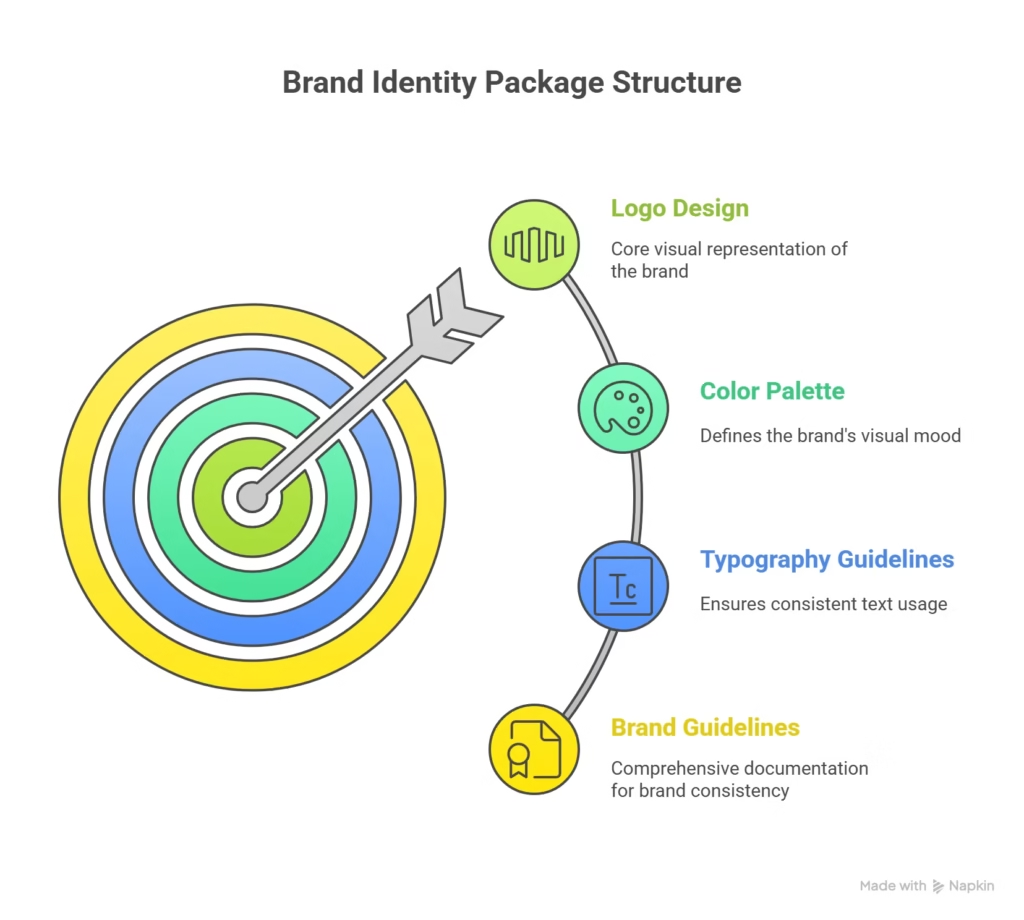
Logo Design: The Visual Anchor of Your Brand
Logo Variations and Applications
A professional logo package includes multiple variations to ensure versatility across different applications. The primary logo serves as the main brand identifier, typically used in most communications. Additionally, businesses receive horizontal layouts for wide spaces, simplified versions for small applications, and icon-only variations for social media profiles.
Most comprehensive brand identity packages include 3-5 logo variations, providing flexibility for any situation. This ensures your logo remains legible and impactful whether it appears on a business card or a billboard.
Logo Psychology and Colour Impact
Logo design psychology plays a crucial role in brand perception. Colours in logos can evoke specific emotions and associations—red conveys passion and excitement, blue suggests trust and reliability, while green represents nature and growth. Understanding these psychological triggers helps businesses choose logo colours that align with their brand personality and target audience expectations.
The choice of shapes, symbols, and visual elements in your logo should reflect your brand’s core values and mission. For example, circular shapes suggest unity and completeness, while angular designs convey strength and stability.
Logo Pricing in the Indian Market
Logo design costs in India vary significantly based on designer expertise and project scope. Budget-friendly options range from ₹1,000 to ₹10,000 for beginner freelancers, while experienced professionals charge ₹10,000 to ₹50,000. Premium logo design services from renowned designers can cost ₹50,000 to ₹1,30,000 or more.
For businesses seeking comprehensive branding, small design studios typically charge ₹2,00,000 to ₹5,00,000, while mid-sized agencies range from ₹5,00,000 to ₹10,00,000 for complete brand identity packages. These higher-tier services include extensive brand research, strategy development, and multiple logo variations.

Typography Systems: Creating Visual Hierarchy
Understanding Typography Hierarchy
Typography hierarchy organizes information by importance, guiding readers through content in a logical order. Effective brand typography systems typically include three basic levels: headings, subheadings, and body text. This hierarchy ensures key messages receive appropriate emphasis while maintaining readability.
Advanced typography systems may include additional levels such as captions, pull quotes, meta information, and display fonts for special applications. Each level should be visually distinct while maintaining cohesion with the overall brand personality.
Font Selection and Brand Personality
Different font categories convey distinct brand personalities. Serif fonts suggest tradition, elegance, and trustworthiness, making them popular for financial institutions and luxury brands. Sans-serif fonts communicate modernity, simplicity, and clarity, often chosen by technology companies and contemporary brands.
Script fonts add personality and warmth, suitable for creative businesses and lifestyle brands, while display fonts make bold statements but should be used sparingly. The key is selecting fonts that align with your brand values and resonate with your target audience.
Typography Consistency and Implementation
Maintaining consistent typography across all brand materials is essential for recognition and professionalism. Brand guidelines should specify exact font families, sizes, weights, and spacing requirements for different applications. This consistency extends to digital platforms, print materials, and environmental graphics.
Professional brand packages typically include 2-3 carefully selected font families—one for headings, one for body text, and occasionally a third for special applications. This limited palette ensures visual cohesion while providing sufficient flexibility for various design needs.
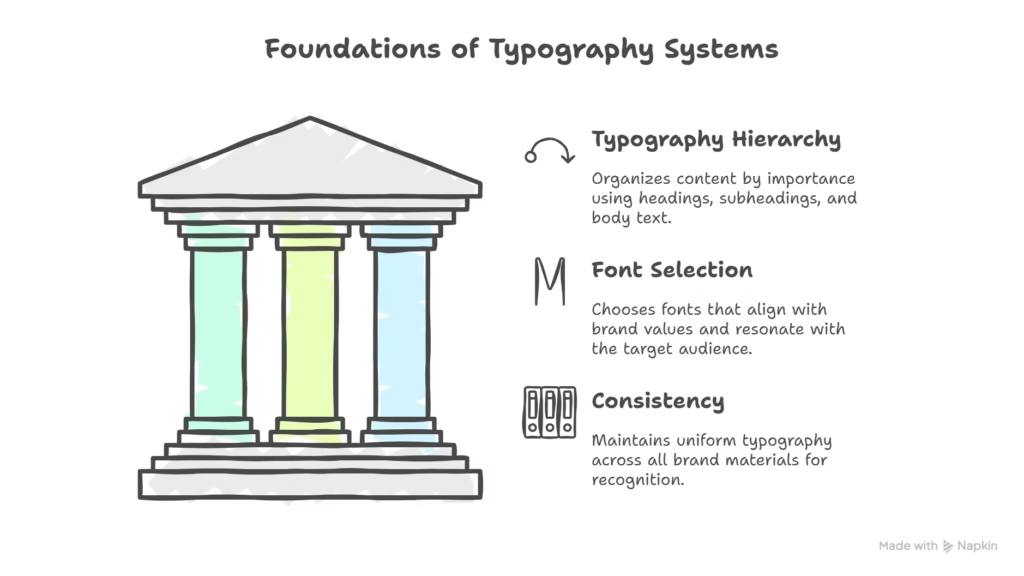
Colour Systems: The Emotional Foundation
Colour Psychology in Indian Branding
where colours carry deep cultural significance. Saffron represents purity and auspiciousness, commonly used by food brands like Haldiram’s. Green symbolizes nature and health, favoured by brands like Himalaya and Ashirwad.
Blue conveys trust and reliability, making it popular among financial institutions like SBI, while red creates urgency and excitement, utilized effectively by brands like McDonald’s and Coca-Cola in the Indian market. Understanding these cultural associations helps brands connect more effectively with Indian consumers.
Developing Comprehensive Colour Palettes
Professional colour systems include primary, secondary, and accent colours that work harmoniously together. The primary colour serves as the main brand identifier, while secondary colours provide variety and depth. Accent colours highlight important elements and create visual interest.
Effective colour palettes consider colour theory principles such as complementary, analogous, and triadic combinations. Research indicates that colour can increase brand recognition by up to 80%, making strategic colour selection crucial for brand success.
Colour Application and Technical Specifications
Brand guidelines must include precise colour specifications for different applications. This includes HEX codes for digital use, CMYK values for print, and Pantone numbers for specialty printing. Clear usage rules prevent colour inconsistencies across different mediums and maintain brand integrity.
Modern colour systems also consider accessibility requirements, ensuring sufficient contrast ratios between text and background colours. This attention to accessibility makes brands more inclusive and improves user experience across all touchpoints.
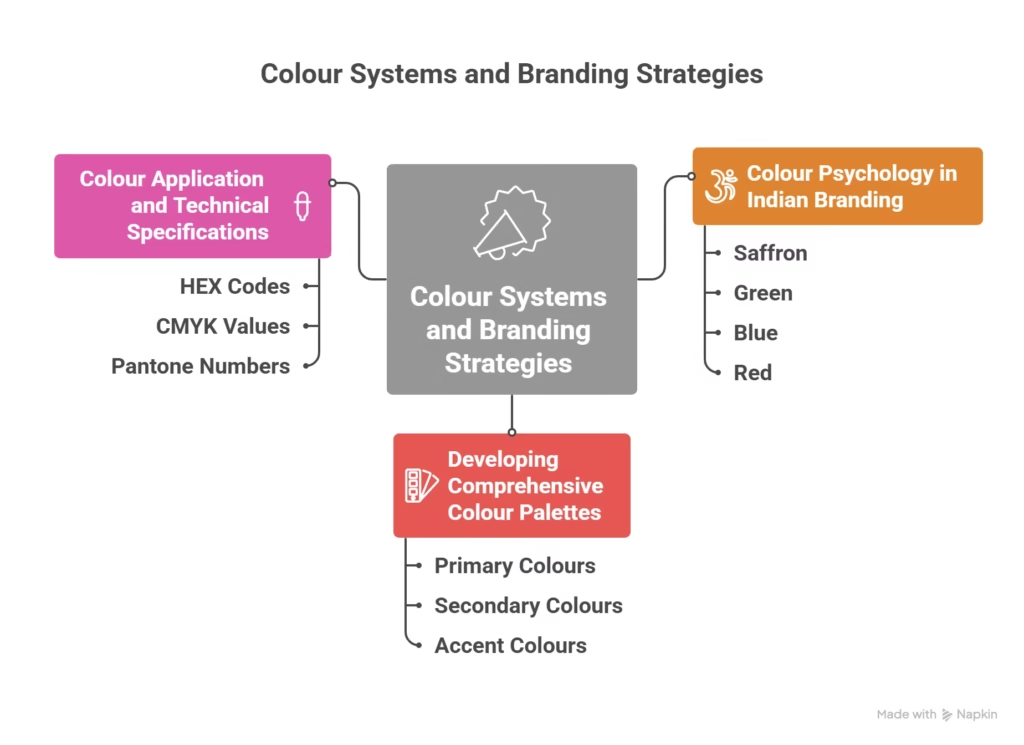
Brand Guidelines: The Master Document
Essential Components of Brand Guidelines
Comprehensive brand guidelines document all visual identity elements and their proper usage. Essential sections include logo usage rules, colour specifications, typography guidelines, and visual style directions. These guidelines serve as the definitive reference for anyone creating branded materials.
Advanced guidelines may include photography styles, illustration approaches, voice and tone specifications, and application examples. The more detailed the guidelines, the better equipped teams are to maintain brand consistency across all communications.
Brand Guidelines Examples and Best Practices
Leading brands create guidelines that are both comprehensive and user-friendly. Companies like Airbnb, Slack, and Spotify provide excellent examples of clear, accessible brand documentation that teams can easily follow.
Effective guidelines use visual examples to demonstrate proper and improper usage, making compliance easier for non-designers. They also include downloadable assets and templates that simplify implementation across different teams and departments.
Implementation and Maintenance
Brand guidelines require regular updates to remain relevant and useful. As brands evolve and expand into new markets or mediums, guidelines must adapt while maintaining core consistency. Digital guidelines platforms make updates easier to distribute and ensure teams always access the most current information.
Training team members on guideline usage is crucial for successful implementation. Many organizations provide workshops or certification programs to ensure everyone understands and follows brand standards consistently.
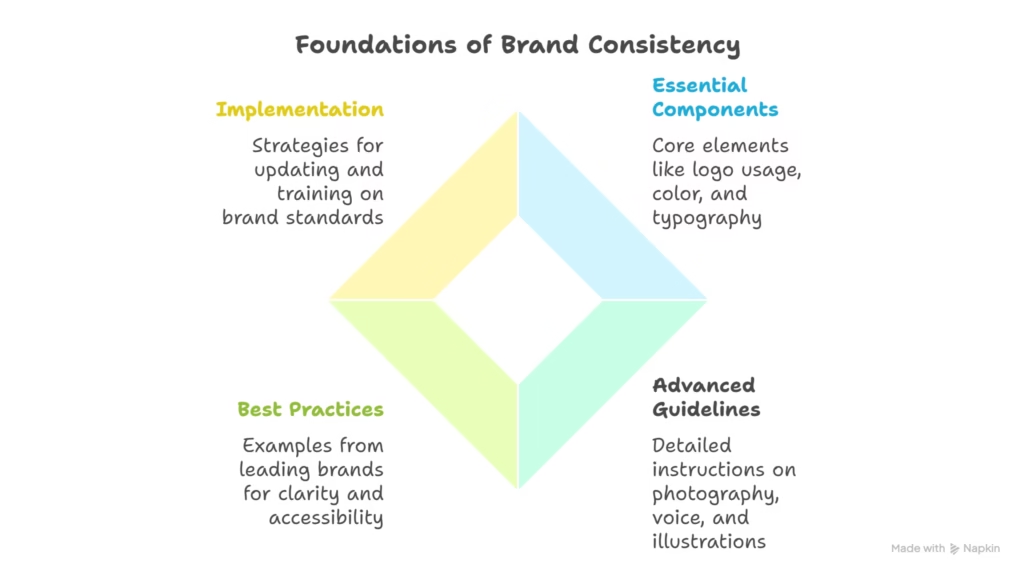
Investment and Pricing in the Indian Market
Brand Identity Package Pricing Structure
Brand identity package costs in India vary significantly based on scope and provider expertise. Basic packages from freelancers start around ₹25,000 to ₹50,000, including logo design, colour palette, and basic typography guidelines.
Mid-range packages from experienced professionals range from ₹50,000 to ₹1,00,000, typically including comprehensive visual identity systems and initial applications. Premium packages from established agencies can cost ₹2,00,000 to ₹10,00,000 or more, incorporating extensive market research, brand strategy, and complete rollout support.
Factors Affecting Branding Costs
Several factors influence brand identity package pricing in India. Designer expertise and reputation significantly impact costs, with renowned professionals commanding premium rates. Project scope affects pricing—basic logo design costs less than comprehensive brand strategy and visual identity development.
Geographic location within India also influences pricing, with metropolitan areas like Mumbai, Delhi, and Bangalore typically charging higher rates than smaller cities. The complexity of design requirements, number of revisions, and timeline constraints all contribute to final project costs.
ROI and Long-term Value
Professional brand identity packages deliver significant long-term value despite upfront investment costs. Consistent branding increases customer recognition, builds trust, and can command premium pricing. Studies show that consistent brand presentation across all platforms can increase revenue by up to 23%.
Well-designed brand systems also reduce future marketing costs by providing clear templates and guidelines for all communications. This efficiency gain often justifies the initial investment within the first year of implementation.

Digital Age Considerations
Responsive Design and Multi-Platform Applications
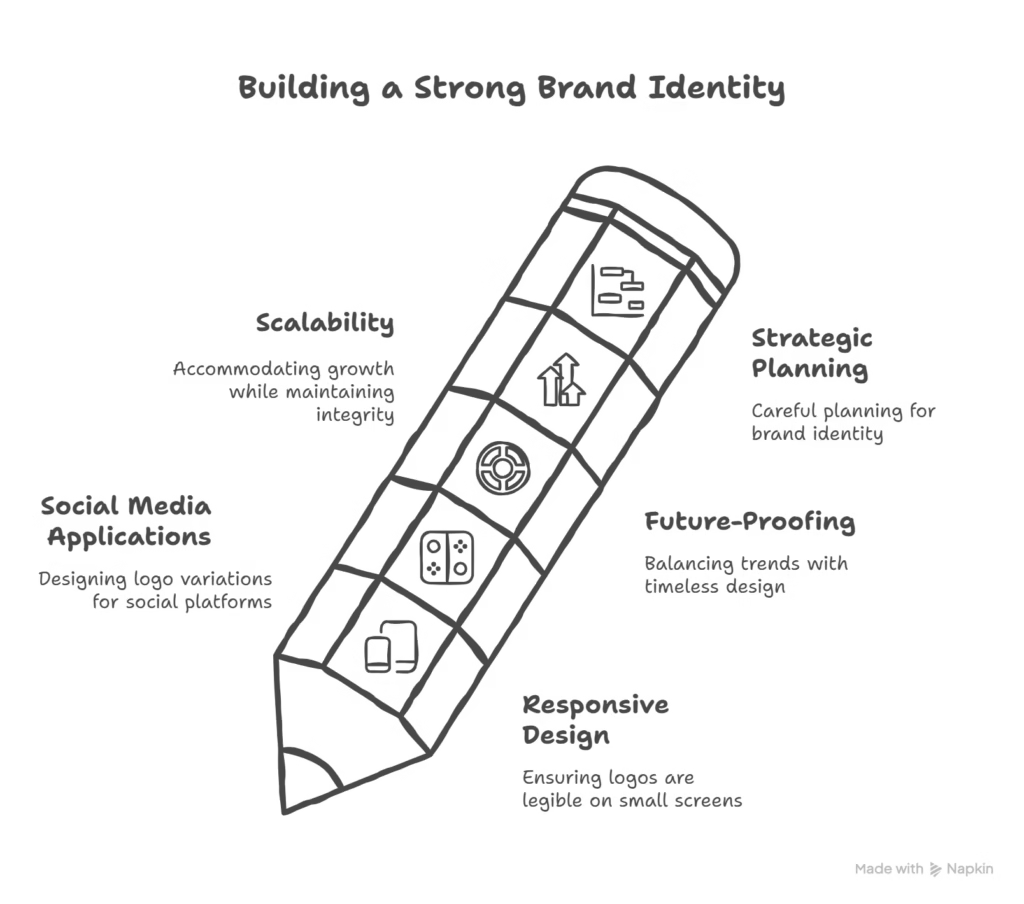
Modern brand identity packages must work effectively across digital platforms and devices. This includes ensuring logos remain legible at small sizes on mobile devices, selecting web-safe typography, and optimizing colours for various screen types.
Social media applications require special consideration, with specific logo variations designed for profile images, cover photos, and story formats. Brand guidelines should address these digital-specific requirements to maintain consistency across all online touchpoints.
Future-Proofing Your Brand Identity
Successful brand identity packages balance current trends with timeless design principles. While incorporating contemporary elements, the core identity should remain relevant and recognizable for years to come. This approach protects the long-term value of your branding investment.
Scalability considerations ensure your brand identity works effectively as your business grows and enters new markets. Flexible design systems accommodate expansion while maintaining brand integrity and recognition.
Creating a comprehensive brand identity package requires careful planning, strategic thinking, and professional execution. By understanding each component’s role and importance, businesses can make informed decisions about their branding investments and build strong, memorable brand identities that drive long-term success. Whether working with freelancers, design studios, or established agencies, the key is ensuring all elements work together harmoniously to create a cohesive and compelling brand experience for your target audience.